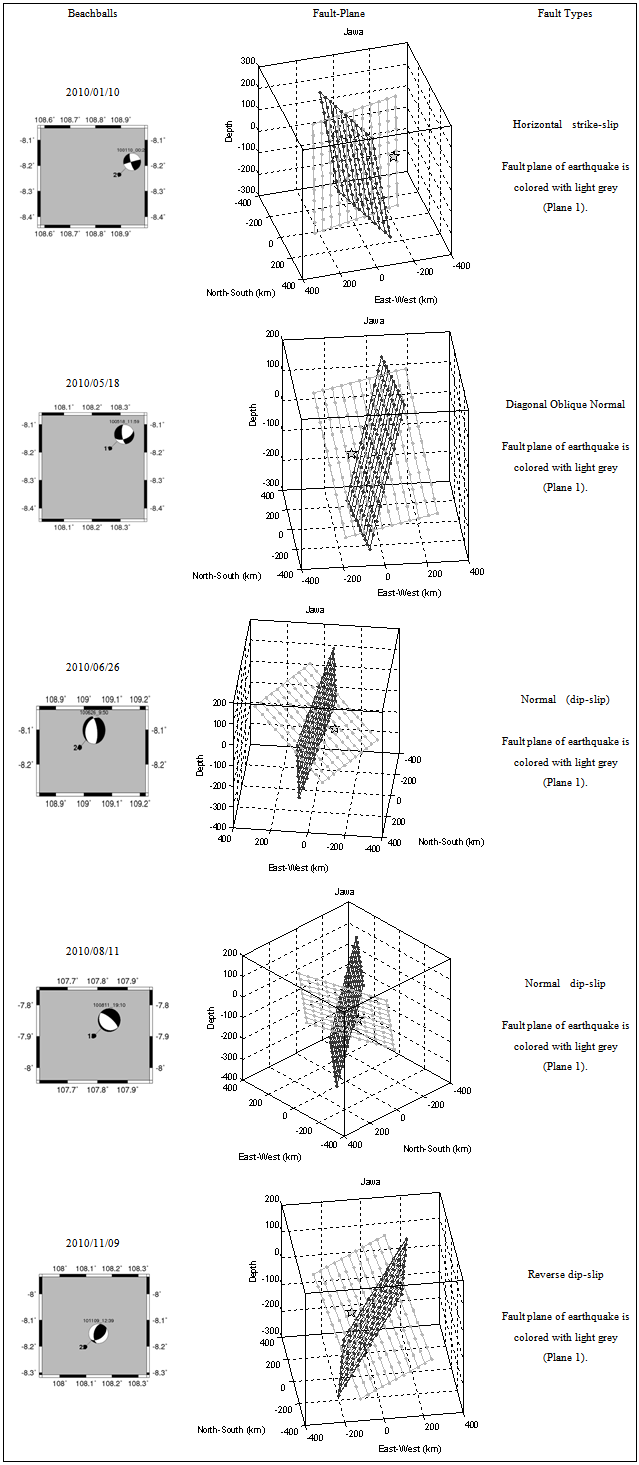-
Paper Information
- Next Paper
- Previous Paper
- Paper Submission
-
Journal Information
- About This Journal
- Editorial Board
- Current Issue
- Archive
- Author Guidelines
- Contact Us
Geosciences
p-ISSN: 2163-1697 e-ISSN: 2163-1719
2013; 3(1): 13-22
doi:10.5923/j.geo.20130301.02
Analysis of Three Components Waveform to Invert The Moments Tensor of Earthquakes in Java 2010
Bagus Jaya Santosa
Physics Department, Fakultas Matematika dan Ilmu Pengetahuan Alam
Correspondence to: Bagus Jaya Santosa , Physics Department, Fakultas Matematika dan Ilmu Pengetahuan Alam.
| Email: |  |
Copyright © 2012 Scientific & Academic Publishing. All Rights Reserved.
The island of Java is an earthquake-prone area. In the last five years IRIS recorded around 294 earthquakes in Indonesia, 28 of which occurred on Java Island. Waveform analysis using three-component seismogram is performed to obtain the moment tensor and to determine the pattern of subduction fault area in the Java Island. This study begins by requesting several earthquake events during 2010 from the BMG-Net, Geofon webpage. Later, the ISOLA software was used to make conversion and pre-processing data, with the program’s input data includes: crustal model, event info, choosing the stations, the preparation of raw data, and determines the seismic source, calculates the Green function, conducting the inversion and plots the inversion results. Then describe the Fault-Plane that caused the earthquake using hcplot software. The results of analysis show that the fracture patterns that develop in Java are a normal faults and reverse faults parallel to the island arc.
Keywords: Waveform Inversion Three Components, Moment Tensor, Fault Plane
Cite this paper: Bagus Jaya Santosa , Analysis of Three Components Waveform to Invert The Moments Tensor of Earthquakes in Java 2010, Geosciences, Vol. 3 No. 1, 2013, pp. 13-22. doi: 10.5923/j.geo.20130301.02.
Article Outline
1. Introduction
- Indonesia region is located between two oceans, two continents and three mega tectonic plates. Indonesia is located on the centre of circum-Pacific global earthquake paths. This has led to several regions in Indonesia are often suffers earthquake with the intensity and magnitude scales ranging from the smallest to the largest scale, particularly in Sumatra, Irian Jaya, South of Java, and Sulawesi.Earthquakes that occurred in Sumatra and Java are the geodynamic implications of active deformation around the Sunda (Java) Trench[1]. Java Trench arc is the result of collisions between two earth plates, which are the oceanic India-Australia plate and the continental Euro-Asia plate. Plate interaction that occurs in the South Java Trench Arc creates a Sunda Trench.In the last five years IRIS recorded around 294 earthquakes in Indonesia, 28 of which occurred on the Java Island. While others are mostly in the island of Sumatra and Irian Jaya, the rest occur in Sulawesi, Sumbawa and other islands. All of the processed Java earthquakes have magnitude over Mw ≥ 5.0.According to McCaffrey[2], Faults in Sumatra and Java, based on its history led to a damaging earthquake. To minimize the damage caused by the earthquake we need to understand the characteristics of the earthquake source.Understanding the fault characteristics which can cause earthquakes is required to estimate and find out the character and consequences of seismicity. Therefore, a moment tensor earthquake modelling is conducted[3-5]. In this model the moment tensor has been analysed using a waveform inversion method or P wave arrival time[4,6].Because seismic waves propagate from the earthquake source to the observation station through earth structure and the exited ground displacement is in three components. The determination of earthquake CMT (Centroid Moment Tensor) using one components Green function, namely the Z-axis direction only, certainly is not enough to accommodate the X and Y components in Cartesian coordinates. In order to use all the seismogram data, we used three components waveform analysis to estimate earthquake source parameters. Furthermore, the seismogram data should be analysed by comparing the observed and synthetic waveform that is calculated using three-component based Green function in the seismogram. This research critics the result of other moment tensor articles, which still used the teleseismic stations, the polarities of Pg and Pn waves, for earthquake source determination and also evaluated only one component for moment tensor inversion[7-18]. In this research, we used three components local broadband that was recorded by Geofon IA network stations. Parameter estimation resulted from an event in several seismological agencies usually have a significant difference, which is caused by different methods used to invert the waveform. Central BMKG on Jakarta used waveform inversion method of only one Z component of the surface wave, Harvard University and USGS used P and S wave for teleseismic data[19]. But most of the methods used above have a distinct red thread that a method will get a high validity if the correlation and reduction variance between measured seismogram and synthetic seismogram has an appropriate value[20].The objective of this paper is to presents the results of waveform analysis in three components of earthquakes in Java in 2010. The data analysis uses local seismic data that is downloaded from the earthquake data IA (BMG-Net, Indonesia) Geofon. The results of this analysis of earthquake parameters including the magnitude, depth and released energy as well as the earthquake faults type.
2. Research Method
2.1. Data Preparation
- The data used are the hypocenter of seismic events in Java recorded by Geofon and/or IA in 2010. 5 events were selected which magnitude are over Mw = 5. All recording are carried out in 3 to 5 nearest stations, while the recording includes three components with good signal-to-noise ratio (SNR).The requested data from Geofon IA are in seed format then converted in the form of SAC through rdseed program in Linux operating system. Next, the SAC binary files and GCF (Guralp Compressed Format) is converted in ASCII format (4 column ASCII data per station, which is a Time, NS, EW and Z components), the SAC and GCF import options provided by the ISOLA software.
2.2. Data Processing
- Flows of each stage of data processing are presented by ISOLA software. Starting from conversion and data pre-processing, inputting data, Green function calculation, moment tensor inversion and plotting the results. After converting the data from SAC binary to ASCII format, the next step is data pre-processing, which include setting up the instrument response, converting and shifting seismograms, select the cut-off frequencies for low-pass filter to eliminate high frequency noise, then the process of data inputting itself.The data inputting process in ISOLA starts from the inputting the crustal model (Figure 1), Event input (Table 1), Selecting stations (Figure 2), Inputting observed Data (Figure 3), and Trial Input Seismic Sources, selecting a single source or multiple sources. The earthquakes epicentre and recording station are illustrated in Figure 4.
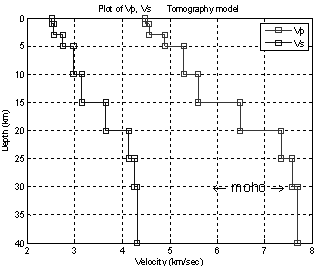 | Figure 1. The Island of Java Crustal Model Plot. Vp = P wave velocity and Vs = S wave velocity |
|
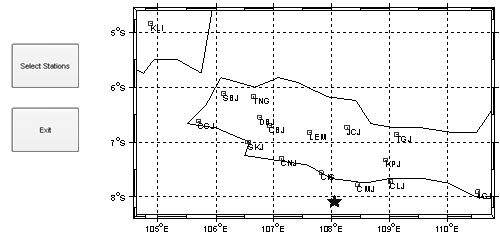 | Figure 2. Station selection Form for Tasikmalaya earthquake [6]data, ie the uncorrected seismograms, must be available in 4‐column text files (with |
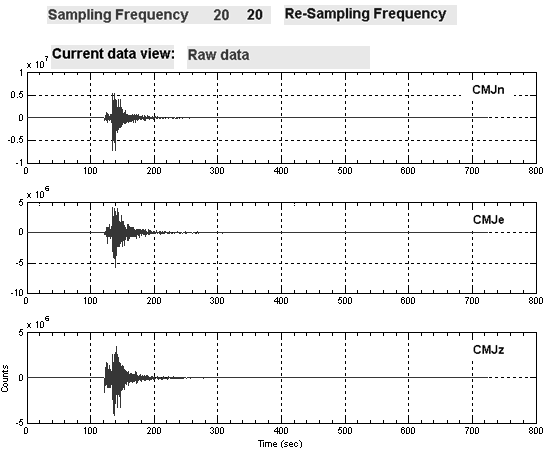 | Figure 3. Seismogram data preparation recorded by CMJI station with N, E and Z components |
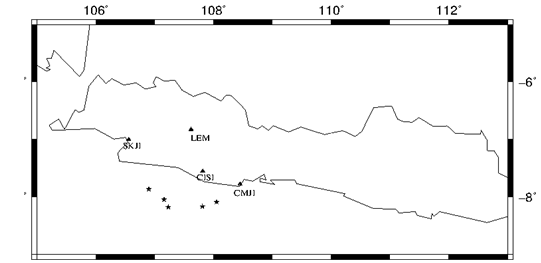 | Figure 4. Map of stations and earthquakes epicentre |
2.3. Inversion Process
- After completing all phases of the data inputting, including definition of the trial source, the inversion process can be started and the first step is to prepare the Green function. Three components Waveform inversion process is carried out using iterative deconvolution method[6,19,21].Inversion results of earthquake parameters are then used to plot the Fault-Plane solution. The plotting process is conducted using hcplot software that is based on the HC method[21]. From the Fault-Plane plot, the subduction fault plane pattern in Java and nearby can be seen.
3. Data Analysis
- The data used is the local seismic data that is downloaded from the IA Geofon earthquake data centre. The earthquakes occurred in Java in 2010. The magnitude, depth, longitude and latitude are presented in Table 1. The selected stations are three nearest stations, including the LEM (JISNET Lembang), CMJI and SKJI (BMKG Cimerak and Sukabumi) and also CISI (Geofon Cisomped), which are all shown in Figure 4.In the analysis of these data, three components local waveform is used (BHN, BHE and BHZ). Source parameters of these earthquakes are estimated using the model inversion to achieve a proper three-component waveform fitting. A good inversion process is based on seismogram matching between observed data and synthetic seismogram. Good results occur when observational data and synthetic data overlap.Local waveform inversion on three components is conditioned on the frequency filter between 0:02 to 0:06 Hz. The relation between the observed waveform on 3 closest stations and synthetic seismograms of each event is obtained from the inversion result. Which are all shown in Figure 5.The earthquake parameters including magnitude, depth and the energy released by the earthquake that occurred on November 09, 2010 are shown in Figure 6. While the parameters of earlier earthquakes are shown in Table 2 for the seismic moment (Mo), Table 3 states Strike, Dip and Rake, and Table 4 states 6 moment tensor components. While the beach balls can be seen in Table 5.
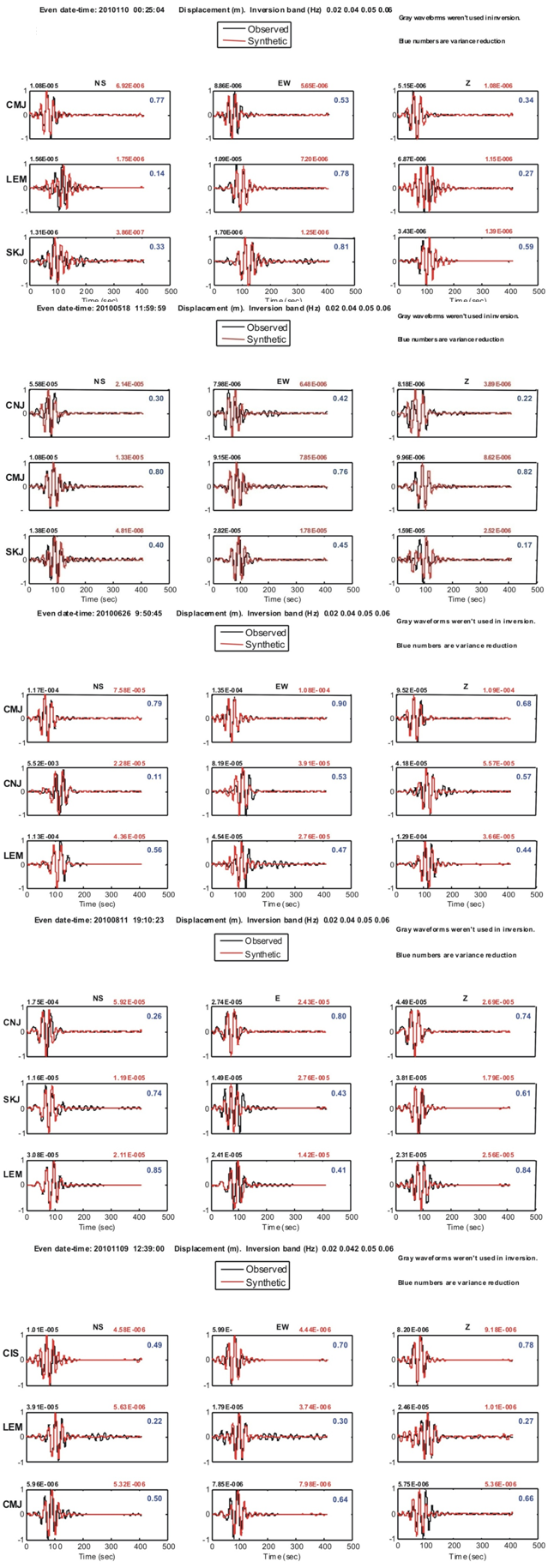 | Figure 5. Three components synthetic and observational seismogram data of 2010 earthquakes. a) January 10th, b) May 18th, c) June 26th, d) August 11th, and e) November 09th |
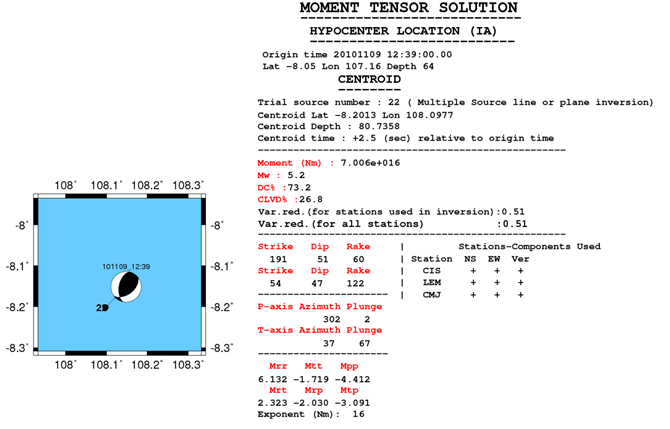 | Figure 6. Moment tensor plotting for 09 Nopember 2010 earthquake |
|
|
|
|
4. Conclusions
- Seismic data analysis through three components waveform inversion is conducted using ISOLA software that aims to estimate the CMT, Fault Plane and earthquake source parameters. The analysis was conducted on 5 earthquakes in the Java Island which occurred in 2010 and obtained from the IA Geofon. The result of this analysis shows that the field of fracture patterns that develop in Java is a normal faults (normal faults) and reverse fault (reverse fault). Most of the fracture tends to point toward the North-South direction, parallel to the direction of plate movement between Southeast Asia and Indo-Australian plate.
 Abstract
Abstract Reference
Reference Full-Text PDF
Full-Text PDF Full-text HTML
Full-text HTML



